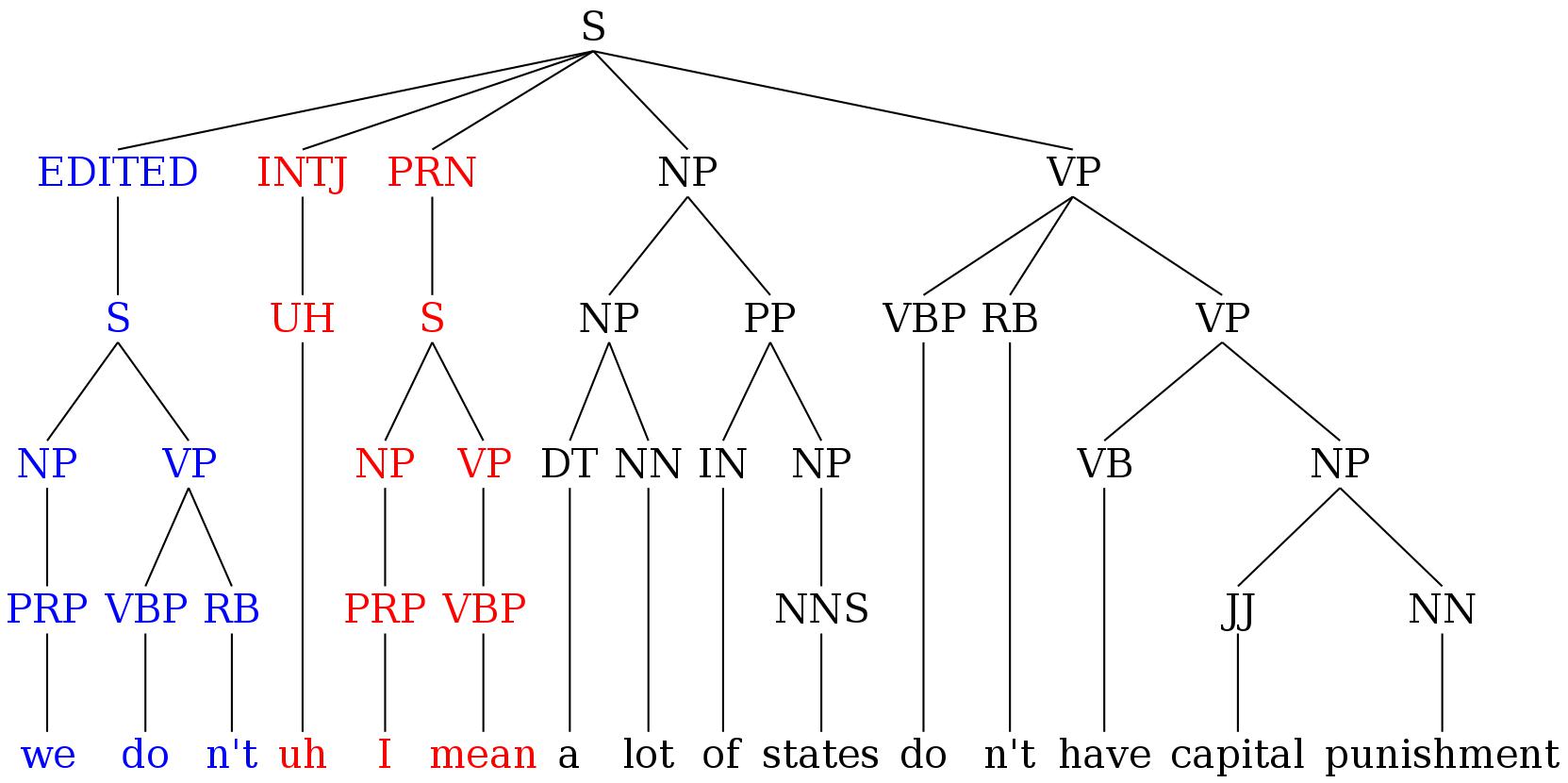A joint disfluency detection and constituency parsing model for transcribed speech based on Neural Constituency Parsing of Speech Transcripts from NAACL 2019, with additional changes (e.g. self-training and ensembling) as described in Improving Disfluency Detection by Self-Training a Self-Attentive Model from ACL 2020.
- Task
- Requirements for Training
- Preparation
- Pretrained Models
- Using the Trained Models for Parsing
- Using the Trained Models for Disfluency Tagging
- Training Instructions
- Reproducing Experiments
- Citation
- Contact
- Credits
Disfluency refers to any interruptions in the normal flow of speech, including filled pauses (um, uh), repetitions (they're ... they're here), corrections (to Sydney ... no to Melbourne), false starts (we would like ... let's go), parenthetical asides (you know, I mean), partial words (wou-, oper-) and interjections (well, like). One type of disfluency which is especially problematic for conventional syntactic parsers are speech repairs. A speech repair consists of three main parts; the reparandum, the interregnum and the repair. As illustrated in the example below, the reparandum we don't is the part of the utterance that is replaced or repaired, the interregnum uh I mean (which consists of a filled pause uh and a discourse marker I mean) is an optional part of the disfluency, and the repair a lot of states don't replaces the reparandum. The fluent version is obtained by removing the reparandum and the interregnum.
This repository includes the code used for training a joint disfluency detection and constituency parsing model of transcribed speech on the Penn Treebank-3 Switchboard corpus. Since the Switchboard trees include both syntactic constituency nodes and disfluency nodes, training a parser to predict the Switchboard trees can be regarded as multi-task learning (where the tasks are syntactic parsing and identifying disfluencies). In the Switchboard treebank corpus the reparanda, filled pauses and discourse markers are dominated by EDITED, INTJ and PRN nodes, respectively. Filled pauses and discourse markers belong to a finite set of words and phrases, so INTJ and PRN nodes are trivial to detect. Detecting EDITED nodes, however, is challenging and is the main focus of disfluency detection models.
- Python 3.6 or higher.
- Cython 0.25.2 or any compatible version.
- PyTorch 0.4.1, 1.0/1.1, or any compatible version.
- EVALB. Before starting, run
makeinside theEVALB/directory to compile anevalbexecutable. This will be called from Python for evaluation. - AllenNLP 0.7.0 or any compatible version (only required when using ELMo word representations)
- pytorch-pretrained-bert 0.4.0 or any compatible version (only required when using BERT word representations)
$ git clone https://github.com/pariajm/joint-disfluency-detector-and-parser
$ cd joint-disfluency-detector-and-parser/EVALB
$ make evalb
$ cd .. To use ELMo embeddings, follow the additional steps given below:
$ mkdir data && cd data
$ wget https://s3-us-west-2.amazonaws.com/allennlp/models/elmo/2x4096_512_2048cnn_2xhighway/elmo_2x4096_512_2048cnn_2xhighway_options.json
$ wget https://s3-us-west-2.amazonaws.com/allennlp/models/elmo/2x4096_512_2048cnn_2xhighway/elmo_2x4096_512_2048cnn_2xhighway_weights.hdf5
$ cd ..The following pre-trained models, which have been optimized for their performance on parsing EDITED nodes i.e. F(S_E) on the SWBD dev set, are available for download:
swbd_fisher_bert_Edev.0.9078.pt: Our best model self-trained on the Switchboard gold parse trees and Fisher silver parse trees with BERT-base-uncased word representations (EDITED word f-score=92.4%).swbd_bert_Edev.0.8922.pt: Our best model trained on the Switchboard gold parse trees with BERT-base-uncased word representations (EDITED word f-score=90.9%).swbd_elmo_tree_transformation_Edev.0.8838.pt: Our best model trained on the tree transformed Switchboard gold parse trees (as described in Section 4.4 here) with ELMo word representations (EDITED word f-score=88.7%).swbd_elmo_Edev.0.872.pt: Our best model trained on the Switchboard gold parse trees with ELMo word representations (EDITED word f-score=87.5%).
Use the pre-trained models to find the constituency parse trees as well as disfluency labels for your own sentences. Before running the following commands, make sure to follow the steps in Requirements for Training and Preparation first. The format of the input in best_models/raw_sentences.txt is one sentence per line. For the best performance, remove punctuations and split clitics ("I 'm" instead of "I'm").
$ cd best_models
$ wget https://github.com/pariajm/joint-disfluency-detector-and-parser/releases/download/naacl2019/swbd_fisher_bert_Edev.0.9078.pt
$ cd ..
$ mkdir model && cd model
$ wget https://s3.amazonaws.com/models.huggingface.co/bert/bert-base-uncased-vocab.txt
$ wget https://s3.amazonaws.com/models.huggingface.co/bert/bert-base-uncased.tar.gz
$ tar -xf bert-base-uncased.tar.gz && cd ..
$ python3 src/main.py parse --input-path best_models/raw_sentences.txt --output-path best_models/parsed_sentences.txt --model-path-base best_models/swbd_fisher_bert_Edev.0.9078.pt >best_models/out.logIf you want to use the trained models to disfluency label your own data, check here.
First, obtain silver parse trees for your unlabelled data by running the commands given in here. Then, you can train a new model on the enlarged training set (gold + silver parse trees) using the following command:
$ python3 src/train_parser.py --config results/swbd_fisher_bert_config.json --eval-path results/eval.txt >results/out_and_error.txtThe code used for our NAACL 2019 paper is tagged naacl2019 in git. The version of the code currently in this repository includes new features (e.g. BERT support and self-training).
If you use this model, please cite the following papers:
@inproceedings{jamshid-lou-2019-neural,
title = "Neural Constituency Parsing of Speech Transcripts",
author = "Jamshid Lou, Paria and Wang, Yufei and Johnson, Mark",
booktitle = "Proceedings of the 2019 Conference of the North {A}merican Chapter of the Association for Computational Linguistics: Human Language Technologies, Volume 1 (Long and Short Papers)",
month = "June",
year = "2019",
address = "Minneapolis, Minnesota",
publisher = "Association for Computational Linguistics",
url = "https://www.aclweb.org/anthology/N19-1282",
doi = "10.18653/v1/N19-1282",
pages = "2756--2765"
}
@inproceedings{jamshid-lou-2020-improving,
title = "Improving Disfluency Detection by Self-Training a Self-Attentive Model",
author = "Jamshid Lou, Paria and Johnson, Mark",
booktitle = "Proceedings of the 58th Annual Meeting of the Association for Computational Linguistics",
month = "jul",
year = "2020",
address = "Online",
publisher = "Association for Computational Linguistics",
url = "https://www.aclweb.org/anthology/2020.acl-main.346",
pages = "3754--3763"
}
Paria Jamshid Lou paria.jamshid-lou@hdr.mq.edu.au
The code for self-attentive parser and most parts of the README file are based on https://github.com/nikitakit/self-attentive-parser.

